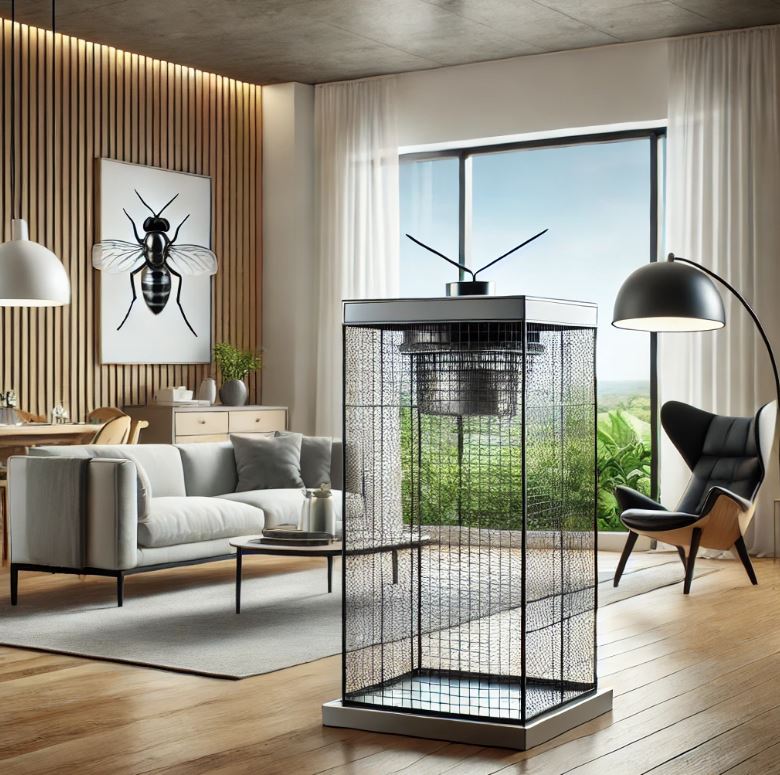I'm a participant in the Amazon Services LLC Associates Program, an affiliate advertising program designed to provide a means for me to earn fees by linking to Amazon.com and affiliated sites.
Using outdoor fly traps indoors might seem like a convenient solution, but it raises several questions about effectiveness, safety, and practicality. Can I use an outdoor fly trap indoors? This article explores whether you can use outdoor fly traps indoors and the considerations to keep in mind.
For those who simply want the Best Indoor Fly Trap, our guide might be extremely helpful to you.
Key Takeaways
- Safety First: Many outdoor fly traps use strong odors or chemicals not suitable for indoor use.
- Effectiveness: Outdoor traps are designed for larger spaces and might not work as efficiently indoors.
- Alternatives: Indoor-specific traps are often more effective and safer for enclosed spaces.
Understanding Outdoor vs. Indoor Fly Traps
Differences in Design and Functionality
Outdoor fly traps are typically designed to cover larger areas and use strong attractants, often with potent odors or chemicals. They work well in open spaces but can be overwhelming and potentially harmful indoors. Indoor fly traps, on the other hand, are engineered to be discreet, odorless, and safe for use in enclosed environments.
Safety Considerations
Using an outdoor fly trap indoors can pose several safety risks. Many outdoor traps contain strong attractants that release odors which can be unpleasant or harmful in enclosed spaces. Moreover, some outdoor traps use toxic substances that are not safe for indoor air quality, particularly in homes with children or pets (Real Simple) (Pest Control Hacks).
Pros and Cons of Using Outdoor Fly Traps Indoors
Pros
- High Capacity: Outdoor fly traps are often designed to handle large infestations, which might be beneficial in severe indoor fly problems.
- Durability: These traps are usually robust and can last longer under harsh conditions.
Cons
- Strong Odors: Many outdoor traps emit strong smells that can be intolerable indoors.
- Chemical Risks: Some traps use pesticides or other chemicals not suitable for indoor use.
- Space Requirements: Designed for open spaces, outdoor traps might be too large or inappropriate for indoor areas (Better Homes & Gardens) (House Grail).
Alternative Solutions for Indoor Fly Problems
UV Light Traps
UV light traps are highly effective for indoor use. They attract flies with UV light and capture them on sticky boards or within a contained area. These traps are silent, odorless, and safe for use around children and pets. The DynaTrap Flylight and Zevo Flying Insect Trap are excellent choices (Family Handyman) (Real Simple).
Sticky Traps
Sticky traps, like the Kensizer Dual-Sided Yellow Sticky Traps, are versatile and can be used in various indoor locations. They are non-toxic and effective for smaller fly species like fruit flies and gnats (Real Simple).
Window Traps
Catchmaster Clear Window Fly Traps are perfect for targeting flies that congregate around windows. These traps are easy to apply and remove, making them a practical choice for indoor use (Family Handyman).
Recent Developments in Fly Trap Technology
As of August 2024, advancements in fly trap technology have focused on enhancing safety and effectiveness. Newer models use eco-friendly materials and non-toxic attractants, making them safer for indoor use. Additionally, improvements in UV light technology have made these traps more efficient in capturing a broader range of insects (Better Homes & Gardens) (House Grail).
Top Experts and Entities in the Field
Dr. Sonja Thomas
An entomologist with the Alabama Cooperative Extension System, Dr. Thomas emphasizes the importance of using appropriate traps based on the type of fly and the environment. Her research highlights the benefits of using indoor-specific traps for safety and effectiveness (Better Homes & Gardens).
PestWorld
PestWorld provides comprehensive guides and reviews on pest control solutions, including the latest fly trap technologies and best practices for indoor and outdoor use (Pest Control Hacks).
Conclusion
While it might be tempting to use outdoor fly traps indoors, it’s generally not advisable due to safety and practicality concerns. Instead, opt for traps specifically designed for indoor use to ensure a safe and effective solution to your fly problems.
For more home improvement tips, check out our articles on The Best Window Air Conditioner for Large Room, Best Desk Fan: Top Picks, and Best Window AC Unit 6000 BTU.
Author: HappyHomeNerd
As an expert in home improvement and pest control solutions, HappyHomeNerd provides well-researched and practical advice to help you maintain a comfortable and pest-free living environment.
